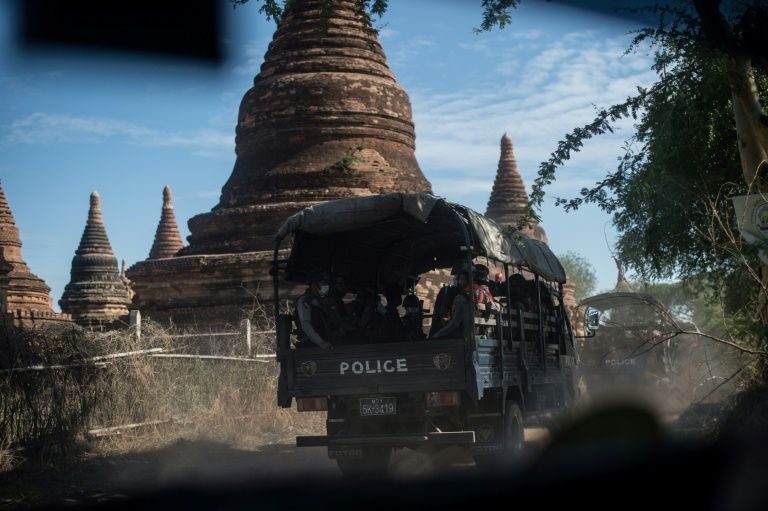Looters target Myanmar temple treasures in tourist slump
A squad of gun-toting police patrol Myanmar’s sacred site of Bagan under the cover of night, taking on plunderers snatching relics from temples forsaken by tourists due to coronavirus restrictions. ©AFP Ye Aung THU
Bagan (Myanmar) (AFP) – A squad of armed police patrol Myanmar’s sacred site of Bagan under the cover of night, taking on plunderers snatching relics from temples forsaken by tourists due to coronavirus restrictions.
Each evening as dusk falls, about 100 officers fan out across the plain of Bagan measuring 50 square kilometres (19 square miles), sweeping torches over the crumbling monuments to scour for intruders.
“Our security forces are patrolling day and night,” Police Lieutenant Colonel Sein Win tells AFP.
“We have it under control for the moment, but it’s a challenge.”
The central Myanmar city is strewn with more than 3,500 ancient monuments — stupas, temples, murals and sculptures — and was finally added to the prestigious UNESCO world heritage list last year.
But the pandemic has stymied plans to capitalise on Bagan’s new-found status.
The dearth of visitors means temples and hotels lie empty, crushing the livelihoods of locals and opening doors to opportunistic burglars.
In a spate of break-ins across the holy site in early June, robbers looted 12 different temples, swiping a range of relics, including copper stupas, ancient coins and jade jewellery.
The 35th Battalion regional police squad have been deployed to bolster local tourism police and firefighters, the teams ranging across the site by jeep, motorbike and foot.
“It’s not easy to patrol as the area is so big,” one police officer says through his face mask, worn by all on duty to protect against COVID-19.
They also need to be on their guard against the area’s numerous venomous snakes, he adds, asking not to be named.
– Temple curse? –
For now, the extra security seems to have thwarted any break-ins at the most prestigious temples.
Some of the relics date back to the 11th-13th century, an era when Bagan was the capital of a regional empire.
This is the first time in decades the site has been so seriously targeted, says Myint Than, deputy director of Bagan’s archaeological department, as he shows at one stupa how the looters scaled the walls to enter from the roof.
“When there were tourists here, there were no burglaries,” he explains, adding he believes this is the work of outsiders.
Even if locals’ livelihoods have been devastated by the tourist downturn, he says he does not believe they would “betray their heritage”.
Times are hard in an area dependent on tourism.
Bagan welcomed nearly half a million visitors in 2019, while this year the figure was 130,000 up until the country’s New Year festival in April and much of the area has been closed to tourists since.
Hotels and restaurants lie shuttered while the hawkers and tuk-tuk drivers not lucky enough to clinch rare construction or farming work wait in vain for customers among the deserted lanes connecting the temples.
Souvenir seller Wyne Yee, 46, says the money she makes in April alone usually keeps food on her family’s table for the following six months.
“But this year we have no money left,” she says wistfully.
She says she is saddened by the desecration of the temples but — like others in the area — is convinced a curse will see the crooks receive their comeuppance.
“The Bagan temples will not tolerate it,” she says. “The robbers will be dealt with.”
Disclaimer: Validity of the above story is for 7 Days from original date of publishing. Source: AFP.


